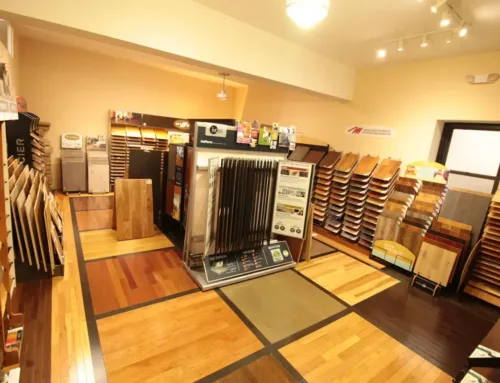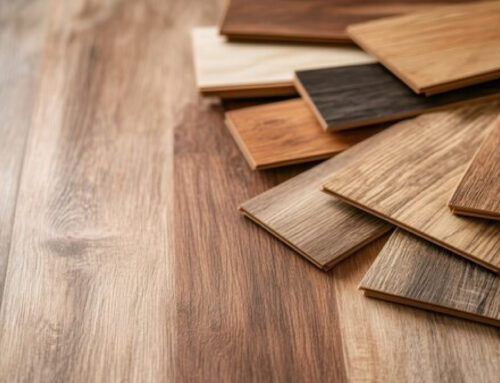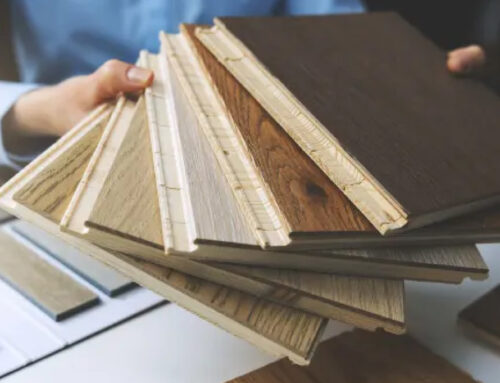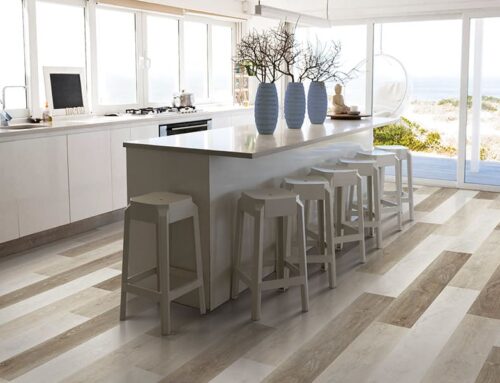Quick Guide: How to Choose Hardwood Floor Color
- Define Your Style
• Modern/minimalist → light or very dark floors
• Traditional → medium warm tones
• Rustic/coastal → natural, distressed or whitewashed looks - Assess Room Size & Light
• Small/low light → lighter woods to brighten and enlarge
• Large/bright → medium to dark for warmth and coziness - Match Your Lifestyle
• High-traffic (kids/pets) → medium tones with visible grain and matte/satin finish
• Low-traffic (no pets/kids) → gloss or uniform colors for drama - Coordinate with Existing Elements
• Cabinetry & furniture → choose contrast or seamless match
• Stone/tile and trim → complement undertones and formality - Choose the Right Species
• Oak → versatile grain, takes stain well
• Maple → light, subtle grain (less receptive to dark stains)
• Walnut/Cherry/Hickory → distinct tones and character - Consider Undertones
• Warm (red/orange/yellow) vs. cool (gray/blue/green)
• Aim for harmony with walls, furnishings, and fixtures - Test Big Samples
• Place 12″×12″ or larger samples in different spots
• Observe under natural and artificial light, at various times - Balance Trends & Timelessness
• Current: light blonde, warm gray, wide planks, matte finishes
• Timeless: medium browns with subtle undertones - Plan for Maintenance
• Very dark → shows dust/scratches easily
• Very light → highlights dirt and stains
• Medium/distressed → most forgiving for everyday wear
Use this guide to quickly zero in on the perfect hardwood hue—one that complements your décor, fits your lifestyle, and endures for years to come.
Visit Your Nearest Rustic Wood Floor Supply Store
Ready to see these beautiful hardwood options in person? Stop by your local Rustic Wood Floor Supply showroom to touch samples, compare finishes, and get personalized advice:
-
Atlanta Store: Explore our curated selection of sustainable woods flooring in the heart of Georgia.
-
Boise Store: Discover the warmth and character of our premium woods flooring at our Idaho location.
-
Spokane Store: Find the perfect floor color to suit your home at our Spokane flooring store.
See you soon—your dream floors are waiting!
Choosing the right hardwood floor color is one of the most important decisions you’ll make during a home renovation or new construction project. Your floors serve as the foundation for your entire home’s aesthetic, affecting everything from wall colors to furniture choices.
Many homeowners feel overwhelmed by the seemingly endless options available, from light white oak to deep walnut and everything in between. Nearly 66% of National Wood Flooring Association (NWFA) members expect increased demand for cleaner, more natural wood colors in 2025, with white oak remaining a dominant selection.
The color you choose not only impacts your home’s style but also influences how spacious rooms appear, how much maintenance will be required, and how well your floors will hide everyday wear and tear. The perfect floor color should complement your home’s style, work with your lifestyle, and stand the test of time.
9 Steps To Choose Hardwood Floor Color
1. Determine Your Design Vision
First of all, take time to consider your overall design vision for your home. Are you aiming for:
- A modern, minimalist look?
- A warm, traditional feel?
- Or perhaps something rustic and organic?
Start by gathering inspiration from design magazines, social media platforms like Pinterest and Instagram, and even homes you’ve visited. Create a collection of images that resonate with your personal style preferences. Pay special attention to how different wood floor colors work within various design schemes.
Your flooring should complement your broader design goals rather than compete with them. For example:
- Contemporary spaces often feature light, natural tones or very dark, dramatic floors
- Traditional homes frequently showcase medium-toned woods with warm undertones
- Farmhouse or rustic styles tend to incorporate natural, distressed finishes with visible grain patterns
- Coastal designs typically include lighter, beachy tones like whitewashed or blonde woods
Hardwood flooring is a long-term investment, so try to look beyond momentary trends and consider what will stand the test of time both aesthetically and functionally.
2. Consider Room Size and Natural Light
The size of your space and the amount of natural light it receives should significantly influence your hardwood floor color choice. These factors directly impact how spacious and inviting a room feels.
For smaller rooms with limited natural light:
- Lighter floor colors like blonde, natural, or whitewashed woods can help create the illusion of more space
- These lighter tones reflect available light, making the room feel brighter and more open
- Wider planks can further enhance this spacious feeling
For larger rooms with abundant natural light:
- You have more flexibility with color choices
- Darker woods like walnut or ebony can add warmth and coziness to prevent the space from feeling too vast
- Medium-toned woods strike a balance and work well in almost any-sized room
It’s also important to consider the direction your windows face. North-facing rooms receive cooler, bluish light that can make cool-toned floors appear even cooler. South-facing rooms get warm, yellowish light that enhances warm undertones in wood.
3. Analyze Your Lifestyle Needs
Your daily life should significantly influence your hardwood floor color choice. Different colors show dirt, scratches, and wear differently, making some options more practical than others depending on your household.
If you have a busy household with children and pets, go for:
- Medium-toned woods (light browns, taupes) tend to hide dirt and scratches better than very light or very dark options
- Floors with visible grain patterns and some color variation naturally camouflage minor damage
- Matte or satin finishes show less dirt and fewer footprints than high-gloss options
If you have a home with dark-haired pets, go for:
- Darker floors can help hide shed fur, though they’ll still show dust more readily
- Consider the color of your pets’ fur when choosing flooring, like light floors show dark fur, and vice versa
If you have a home with minimal traffic and no adults, you have more flexibility to choose based on aesthetic preferences alone. In such cases, high-gloss finishes and uniform colors become more practical options
4. Evaluate Existing Elements
Unless you’re building from scratch or completely renovating, you’ll need to consider how your new flooring will work with existing elements in your home. This includes cabinetry, furniture, trim, wall colors, and architectural features.
When working with existing cabinetry:
- Avoid choosing wood flooring that’s too similar to your cabinet color and aim for contrast instead
- With dark cabinetry, consider lighter to medium floor tones
- With light cabinetry, you have the flexibility to go lighter for a seamless look or darker for contrast
When dealing with stone or tile in your home:
- Identify the undertones in your stone (warm/cool) and choose flooring with complementary undertones
- Match the level of formality, rustic stone pairs well with more natural, textured wood. Polished stone works with refined wood finishes
If you have distinctive trim or millwork:
- Consider whether you want your flooring to match or contrast with these elements
- Matching creates a cohesive, traditional look
- Contrasting can highlight architectural details
Take samples of your flooring options home and place them near your existing elements to see how they work together. Remember that you’re creating a cohesive environment where all elements should complement rather than compete with each other.
5. Understand Wood Species Characteristics
Different wood species have inherent color ranges and grain patterns that affect their appearance, even before any stain is applied. Understanding these characteristics helps you choose a wood that naturally aligns with your color preferences.
Popular hardwood species include:
- Oak: Available in red oak (warmer, reddish undertones) and white oak (cooler, more neutral undertones). Oak has prominent grain patterns and accepts stain well.
- Maple: Naturally light with subtle grain patterns. Maple has a clean, uniform appearance but doesn’t accept dark stains as well as oak.
- Walnut: Naturally medium to dark brown with chocolate undertones. Walnut has a rich, luxurious appearance even without stain.
- Hickory: Features dramatic color variation and distinctive grain patterns. Great for rustic or character-rich spaces.
- Cherry: Starts amber-colored but darkens substantially over time with exposure to light. Cherry has a smooth grain and warm appearance.
The natural characteristics of each wood species will influence how stains appear when applied. For example, a medium brown stain will look different on oak than on maple due to their different base colors and how they accept stain. Working with the natural properties of each wood species rather than against them often produces the most beautiful results.
6. Consider Undertones Carefully
Undertones are subtle color hints that exist beneath the primary color of the wood. They can be warm (red, orange, yellow) or cool (gray, blue, green). Understanding and identifying undertones is crucial for creating a harmonious look in your home.
When evaluating undertones:
- Look at samples in natural light to identify whether they lean warm or cool
- Consider your wall colors, furniture, and fixtures. Do they have predominantly warm or cool undertones?
- For a cohesive look, match the undertones of your flooring with other prominent elements in your space
Most design experts warn against very red or orange undertones in flooring, as these can appear dated. However, subtle warm undertones can create inviting spaces, while cool undertones offer a more contemporary feel.
One trending option is warm gray flooring, which blends cool gray tones with warmer undertones for a balanced, livable look that works in various design styles. This creates a modern aesthetic while avoiding the starkness of pure cool tones.
7. Test Samples in Your Space
Never make a final decision based solely on showroom lighting or online photos. Light varies dramatically from home to home and even room to room, significantly affecting how floor colors appear.
To properly test samples:
- Obtain large samples (at least 12″x12″) of your top choices
- Place them in different areas of your home, including corners and areas near windows
- Observe how they look at different times of day as natural light changes
- View them alongside your furniture, cabinets, and wall colors
- Consider how they look under your artificial lighting in the evening
If you’re having trouble deciding between options, try narrowing down to two or three finalists and living with the samples for several days. Notice which one you’re consistently drawn to and which looks best under the widest variety of lighting conditions.
When possible, ask to see examples of your chosen stain on the actual wood species you’re considering, not just generic color chips.
8. Balance Trends with Timelessness
Flooring trends come and go, but your hardwood floors might last 30+ years. Finding the right balance between contemporary appeal and enduring style is key to long-term satisfaction.
Current flooring trends include:
- Light, natural blonde woods for a Scandinavian-inspired look
- Warm gray tones that bridge modern and traditional styles
- Matte finishes rather than high-gloss
- Wider planks for a contemporary feel
- Natural-looking finishes that showcase the wood’s character
While it’s fine to be influenced by trends, consider how long you plan to stay in your home and whether the trend complements your home’s architecture.
The most timeless options tend to be medium brown tones with subtle undertones and traditional plank widths. These provide a neutral foundation that works with various decorating styles as your tastes evolve over time.
9. Consider Long-Term Maintenance Requirements
Different hardwood floor colors require different levels of maintenance, which can affect your daily life for years to come. Being realistic about your cleaning habits and tolerance for visible dirt is important.
Maintenance considerations by color:
- Very dark floors (espresso, ebony): Show dust, scratches, and pet hair most prominently; require frequent cleaning
- Very light floors (whitewashed, blonde): Show less dust but can highlight dirt, stains, and dark pet hair
- Medium tones (honey, chestnut): Generally, the most forgiving for everyday life and maintenance
- High-variation colors and distressed finishes: Best at hiding scratches and dents from active households
Beyond color, also consider:
- Finish type: Matte/satin finishes hide scratches better than high-gloss options
- Texture: Hand-scraped or wire-brushed finishes conceal wear better than smooth finishes
- Engineered vs. solid: Some engineered options offer enhanced durability for active households
Be honest with yourself about how much time you’re willing to devote to floor maintenance. If you dislike frequent cleaning but love the look of dark floors, you might need to compromise or consider adding more entryway rugs and regular cleaning routines to maintain their appearance.
Bottom Line
Take your time with this decision, as rushing often leads to regret with such a significant investment. The perfect hardwood floor color will serve as a beautiful foundation for your home for many years to come.
At Rustic Wood Floor Supply, we understand that your floors are the canvas upon which your home’s entire story unfolds. Our curated collection of premium hardwoods showcases nature’s finest artistry. We source only the highest quality sustainable hardwoods, offering distinctive character that mass-produced options simply can’t match.
Visit Rustic Wood Floor Supply’s store near you to witness these remarkable woods firsthand, where you can touch the textures, observe how light plays across different finishes, and envision how each option would transform your space.
FAQs
How do hardwood floor colors affect room size perception?
Light-colored floors make rooms appear larger by reflecting more light. Dark floors create intimacy but can make small rooms feel smaller. For maximum spaciousness, choose blonde or natural finishes. In oversized rooms where you want coziness, darker tones can help “bring the walls in” visually.
Will my hardwood floors change color over time?
Yes, most hardwood naturally changes color with sunlight exposure. Cherry darkens considerably, while maple may develop an amber patina. UV-cured finishes slow this process, but don’t eliminate it. Rotate area rugs periodically to ensure even aging, especially in sunny rooms.
Should my hardwood floor color match my kitchen cabinets?
Rather than matching exactly, floors and cabinets should complement each other. Direct matching creates a flat, monotonous look. Aim for contrast while keeping undertones consistent. With light cabinets, you can go light for a seamless look or dark for contrast. With dark cabinets, medium to lighter floors generally create a balanced appearance.
How do I test hardwood floor colors in my home?
Get large samples (at least 12″x12″) and place them in different areas of your home. View them during morning, afternoon, and evening, as well as under artificial lighting. Place them against walls and cabinets. Take photos under different lighting conditions to compare options objectively. Live with samples for several days before deciding.
Author Profile
- I have worked in hardwood flooring for the last 8 years. Use to run a company of residential crews as well as a company with gym flooring. If you need floor installation or refinishing help, I should have an answer or at least get you in the right direction.
Latest entries
 FlooringDecember 24, 2025Right Advice For Picking The Ideal Hardwood Flooring Options
FlooringDecember 24, 2025Right Advice For Picking The Ideal Hardwood Flooring Options FlooringDecember 22, 2025What is Your Favorite Type of Hardwood Flooring and Why?
FlooringDecember 22, 2025What is Your Favorite Type of Hardwood Flooring and Why? FlooringDecember 15, 2025What is the Most Durable Engineered Hardwood Flooring?
FlooringDecember 15, 2025What is the Most Durable Engineered Hardwood Flooring?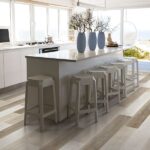 FlooringDecember 12, 2025How Do You Maintain Vinyl Flooring in Spokane Homes?
FlooringDecember 12, 2025How Do You Maintain Vinyl Flooring in Spokane Homes?

